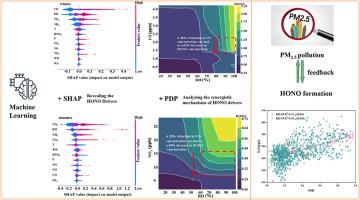Driving factors of HONO and their synergy in Hohhot, a semi-arid city in northern China: Insights from interpretable machine learning approaches
IF 3.7
2区 环境科学与生态学
Q2 ENVIRONMENTAL SCIENCES
引用次数: 0
Abstract
Nitrous acid (HONO) serves as the key source of hydroxyl radicals (OH) in the atmosphere, significantly impacting atmospheric photochemical reactions and air quality. However, the source and formation process of HONO are influenced by numerous factors, and their synergy leads to a limited understanding of its formation mechanisms. In this study, we utilized a random forest (RF) model to elucidate the nonlinear relationships between these driving factors and HONO concentrations in winter and summer. To gain further insights, we combined RF model with SHapley Additive exPlanations and Partial Dependence Plot methods to reveal the sources, driving factors, and their synergy. The findings suggest that HONO is primarily driven by both primary emissions and NO2 transformation in winter, but by the heterogeneous transformation of NO2 in summer. A potential connection exists between winter PM2.5 pollution and HONO. By limiting primary emissions, HONO concentrations can be reduced, which in turn helps mitigate winter PM2.5 pollution. To lower HONO levels in summer, a synergistic approach is needed to control both NO2 and NH3, particularly under high relative humidity. The findings presented herein enhance our understanding of the HONO formation mechanisms and provide a scientific basis for developing comprehensive air quality improvement strategies.

中国北方半干旱城市呼和浩特HONO的驱动因素及其协同效应:来自可解释机器学习方法的见解
亚硝酸(HONO)是大气中羟基自由基(OH)的主要来源,对大气光化学反应和空气质量有重要影响。然而,HONO的来源和形成过程受多种因素的影响,这些因素的协同作用导致对其形成机制的理解有限。在本研究中,我们利用随机森林(RF)模型来阐明这些驱动因素与冬季和夏季HONO浓度之间的非线性关系。为了获得进一步的见解,我们将RF模型与SHapley加性解释和部分依赖图方法相结合,以揭示来源,驱动因素及其协同作用。研究结果表明,HONO在冬季主要由一次排放和NO2转化驱动,而在夏季主要由NO2的异质性转化驱动。冬季PM2.5污染与HONO之间存在潜在联系。通过限制一次排放,可以降低HONO浓度,从而有助于减轻冬季PM2.5污染。为了降低夏季的HONO水平,需要采取协同方法同时控制NO2和NH3,特别是在高相对湿度条件下。研究结果有助加深我们对HONO形成机制的认识,并为制定全面的空气质素改善策略提供科学依据。
本文章由计算机程序翻译,如有差异,请以英文原文为准。
求助全文
约1分钟内获得全文
求助全文
来源期刊

Atmospheric Environment
环境科学-环境科学
CiteScore
9.40
自引率
8.00%
发文量
458
审稿时长
53 days
期刊介绍:
Atmospheric Environment has an open access mirror journal Atmospheric Environment: X, sharing the same aims and scope, editorial team, submission system and rigorous peer review.
Atmospheric Environment is the international journal for scientists in different disciplines related to atmospheric composition and its impacts. The journal publishes scientific articles with atmospheric relevance of emissions and depositions of gaseous and particulate compounds, chemical processes and physical effects in the atmosphere, as well as impacts of the changing atmospheric composition on human health, air quality, climate change, and ecosystems.
 求助内容:
求助内容: 应助结果提醒方式:
应助结果提醒方式:


